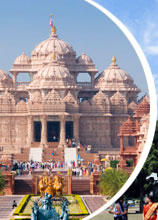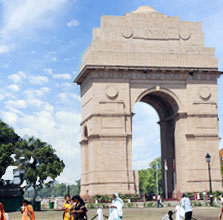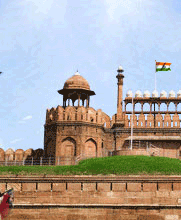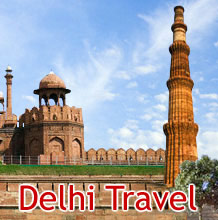 There
are a number of tourist attractions in Delhi that will keep you busy and
amused throughout your stay in the city. Infact, there are so many
places to see in Delhi, India that it is almost impossible to cover them
all in a single trip. Old Delhi offers some magnificent attractions like
Red Fort, the historical Chandni Chowk and so on. Not to be left behind
is New Delhi sightseeing that boasts of many government buildings,
embassies, along with a number of historical places. Some of the famous
tourist attractions of Delhi are mentioned below:
There
are a number of tourist attractions in Delhi that will keep you busy and
amused throughout your stay in the city. Infact, there are so many
places to see in Delhi, India that it is almost impossible to cover them
all in a single trip. Old Delhi offers some magnificent attractions like
Red Fort, the historical Chandni Chowk and so on. Not to be left behind
is New Delhi sightseeing that boasts of many government buildings,
embassies, along with a number of historical places. Some of the famous
tourist attractions of Delhi are mentioned below: Humayun's Tomb
Humayun's Tomb, the mausoleum of Mughal emperor Humayun, is situated on the Mathura Road, near it's crossing with Lodi Road. The first significant model of Mughal architecture in India, the tomb was built by Humayun's wife Haji Begum in the year 1565.
India Gate
India Gate is a war memorial of martyred soldiers, situated in the middle of New Delhi. Standing tall at a height of 42 m, Delhi India Gate, an "Arc-de-Triomphe", seems like a gateway at the heart of a crossroad. His Royal Highness, the Duke of Connaught laid the foundation stone of India Gate in the year 1921.
Jantar Mantar Delhi
Jantar Mantar, with Yantra meaning instruments and Mantra meaning formulae, was built in the year 1724. Situated near Connaught Place, New Delhi Jantar Mantar counts amongst the numerous astronomical observatories erected by Maharaja Jai Singh II of Jaipur. The other observatories consist of the ones built in Jaipur, Varanasi, Ujjain and Mathura.
Lodi Tomb
Lodi Tomb is situated amidst the famous Lodi Garden, adjoining the Indian International Centre in South Delhi. It is one of the many mausoleums in the city that have been built inside a garden. Lodi Tomb entombs Sikandar Lodi. The other mausoleums situated inside the Lodi Gardens, along with the Lodhi tomb, include the Tomb of Muhammad Shah, Shish Gumbad and Bara Gumbad.
Lal Gumbad
Lal Gumbad, also known as Rakabwala Gumbad, entombs Shaikh Kabir-Ud-Din Auliya, a disciple of Shaikh Raushan Chiragh-I-Delhi. Situated in the Malviya Nagar area of South Delhi, it is believed to have been constructed in the mid-fourteenth century. The mortal remains of Shaikh Kabir-Ud-Din Auliya were buried here in 1397.
National Zoological Park
Established in the year 1959, Delhi National Zoological Park lies near the famous Old Fort. One of the best zoos in the entire Asian continent, its uniqueness is that it tries to provide an almost natural habitat to the animals and birds houses here. It proves to be an ideal picnic spots, especially in winters, and is spread over an area of 214 acres.
Parliament House
Parliament House accommodates the two Houses of Parliament, Lok Sabha (House of the People) and Rajya Sabha (Council of States). Sir Edwin Lutyens and Sir Herbert Baker, the architects of New Delhi, designed this building. His Royal Highness, the Duke of Connaught, laid the foundation stone of Parliament House in the year 1921.
Qutab Minar
The famous Qutab Minar of Delhi is a tower that claims the distinction of being the highest stone tower in the country. Said to be a tower of victory, it soars to a height of 73 m. Qutab-ud-din Aibak, after defeating Delhi's last Hindu kingdom, started the construction of this tower in the year 1193. Although Qutab-ud-din Aibak started the construction of the tower, he could not complete the monument during his lifetime.
.
Rashtrapati Bhavan
It was decided in the Delhi Durbar of 1911 that the capital of India would be shifted from Calcutta to Delhi. Thus was born the city of Delhi, designed by the great architect Edwin Lutyens, along with Herbert Baker. It took approximately 20 years and 15 million pounds to build New Delhi.
Rajghat
Rajghat is the last resting place of Mahatma Gandhi, the Father of the Nation. The cremation of Mahatma Gandhi took place at the Delhi Raj Ghat only, on 31st January 1950. The memorial stone of Mahatma Gandhi placed there is a simple square platform made of black stone, with the words "Hey Ram" inscribed near it.
Safdarjung's Tomb
Safdarjung's Tomb entombs Muqim Abul Mansur Khan, also known as Safdarjung. He was the viceroy of Awadh under the Mughal Emperor, Mohammed Shah and later became his prime minister. Nawab Shuja-ud-Daulah, Safdarjung's son, constructed Delhi Safdarjung's Tomb, the last garden tomb in the city, in the year 1753-54.









